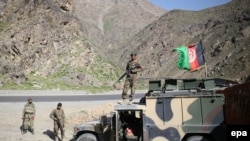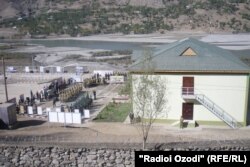A remote, picturesque province in northwestern Afghanistan famous for its lapis lazuli mines, high mountains and whitewater rivers was once considered one of the most stable regions in the country.
But recent fierce fighting in Badakhshan, which left at least 18 Afghan soldiers killed, some of whom the Taliban beheaded, has showcased how vulnerable the region is to hard-line Islamist militants who consider it a prized territory because it borders, Pakistan, Tajikistan and China.
Jurm, a district in the center of Badakhshan, was the scene of fierce fighting between Afghan troops and some 200 Taliban including foreign fighters.
The April 10 battle in Jurm's Dara-e Khustak valley exposed the extent of Badakhshan's defenselessness.
All of the 28 Afghan soldiers serving in remote outposts were killed or wounded, and the insurgents fled into the mountains with their weapons. The soldiers received no assistance or reinforcements from the Afghan security forces, and there were no airstrikes to support them.
Badakhshan Governor Shah Waliullah Adeeb told RFE/RL's Gandhara website that most of the attackers were foreigners.
"Some 200 fighters, some of them with their families, are now based in the Dara-e Khustak area. As the weather gets warmer they might increase in number," he said. "As far as we know, the foreigners from Uzbekistan, Tajikistan, Chechnya and other countries are now involved in making Badakhshan insecure."
Adeeb added that at least 30 fighters including foreign nationals were also killed in Jurm.
Colonel Sakhidad, a senior police official in Badakhshan, says that among those killed four were Tajik nationals. He told Gandhara the militants had infiltrated Afghanistan through Shughnon and Ishkoshim districts in neighboring Tajikistan's Gorno-Badakhshan region.
Mahdi Saber, a security analyst in Tajikistan's capital Dushanbe, however, disagrees.
He told Gandhara few militants infiltrate Afghanistan across its 1,300-kilometer border with Tajikistan. Instead, he says, Central Asian militants are infiltrating Badakhshan from Pakistan's remote Chitral district, which borders Badakhshan.
"No fighter can cross from Tajikistan into Afghanistan because the border is heavily guarded," he said, "The foreign fighters now active in Badakhshan are members of the Islamic Movement of Uzbekistan (IMU) and affiliated groups who were trained at Taliban militant camps inside Pakistan."
The IMU is a banned organization in Tajikistan and neighboring countries. Since its emergence in the 1990s, it has been the target of government crackdowns across Central Asia.
Hundreds or even thousands of IMU members fled into Pakistan's northwestern tribal areas after the demise of Afghanistan's Taliban regime in 2001. The Taliban hosted them in northern Afghan provinces bordering Tajikistan, Uzbekistan and Turkmenistan.
The IMU is seen as being on the run once again after a major Pakistani military operation dislodged them from their main sanctuary in the North Waziristan tribal district last summer.
Last week, Gandhara reported that some Pakistani and Central Asian militants have carved a sanctuary in the southern Afghan province of Zabul. The fighting and official claims now suggest that Central Asian militants are trying to build a similar base in Badakhshan, which will help in projecting power into their home countries.
In recent months, Central Asian leaders and senior Russian officials have repeatedly voiced concern over the withdrawal of U.S.-led NATO forces from Afghanistan.
They worry the escalating violence in Afghanistan might spill over into its northern neighbors.
In response to the heightened threats, U.S. President Barack Obama announced a slowdown of the withdrawal of U.S. troops from Afghanistan last month. The remaining 9,800 American troops will now stay in the country through the end of 2015.
All U.S. troops are scheduled to leave Afghanistan by the end of 2016.
The more than 350,000 Afghan security forces which they helped prop up by investing some $65 billion still remain ill-equipped and undertrained.
Adeeb, the Badakhshan governor, say this makes his province vulnerable to militant infiltration.
"Certainly, our police have a lot of problems from the standpoint of equipment. And even our army units here need heavy weapons and more training."
In the Afghan capital Kabul, the deteriorating security in Badakhshan has unleashed a blame game.
Afghan Chief of Army Staff Sher Mohammad Karimi blamed leadership failure and a lack of aircraft for the Badakhshan debacle.
"Soldiers fought bravely. There are issues in leadership, [the] commander of the unit was not available at the time of the attack," he told a parliamentary committee on April 14.
Fawzia Koofi, an outspoken lawmaker from Badakhshan, however, blamed the Afghan Defense Ministry for not providing timely support to the soldiers in Jurm.
"Some 28 soldiers were left isolated in Jurm, Badakhshan, without fuel, ammunition, air support or radio communication with the rest of the Afghan Army," she wrote on her Facebook page.
"This resulted in having them all captured by the terrorists and mercilessly beheaded," she said. "Now the question is, who is responsible for this crime? The terrorists or the corrupt army generals?"
Jawid Kohistani, a senior security analyst in Kabul agrees.
"The senior leadership of the Afghan Defense Ministry should be blamed for inaction and negligence," he said. "In fact, the ministry suffers from mismanagement, and its senior leaders did little to help their besieged soldiers."
as/fg









